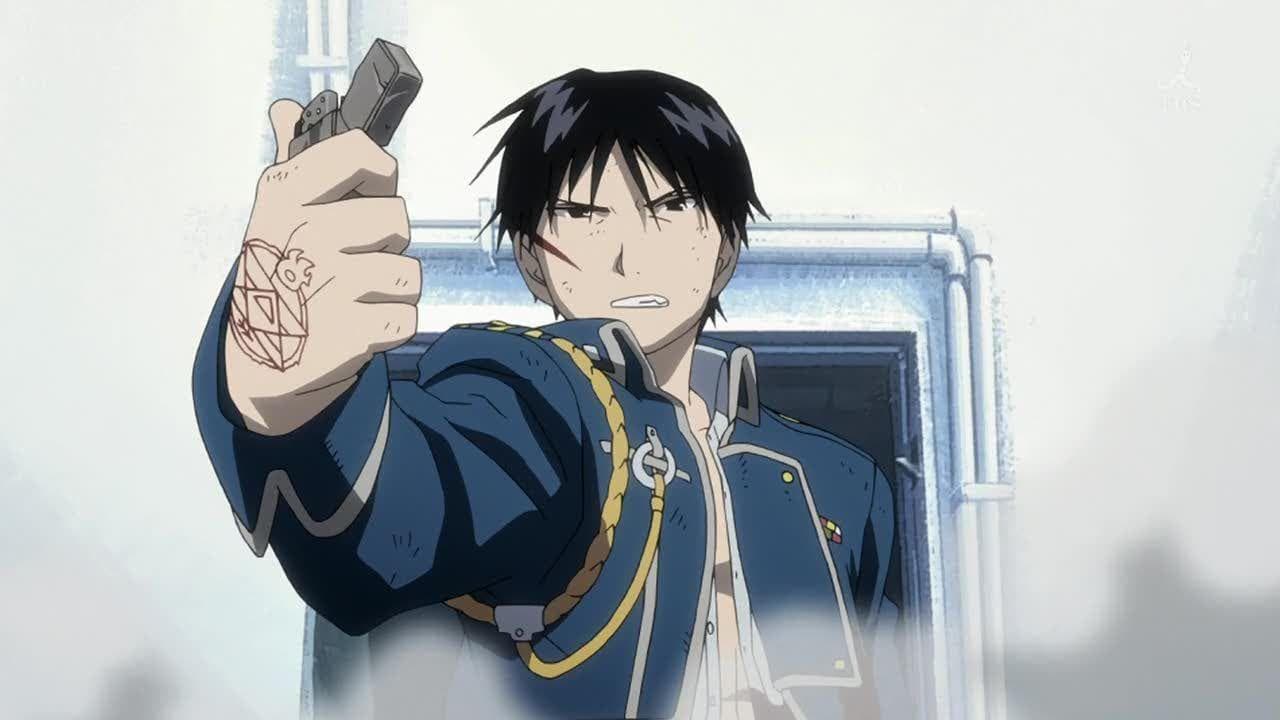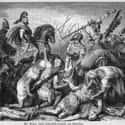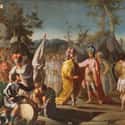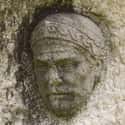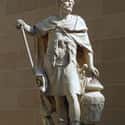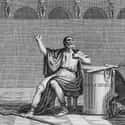-
(#1) Hannibal's Father Was Undefeated In Battle
As a General during the first Punic War, Hamilcar Barca, Hannibal's father, who was also known as "Barcas," fought on the side of Carthage against Rome in the 240s BCE. Though he never lost a land battle himself, ultimately, Carthage lost the battles over Sicily. Hamilcar was then in poor spirits when he returned home to his young son Hannibal.
Hamilcar saw in young Hannibal what many fathers see in their sons: an opportunity to get revenge on his enemies. He raised Hannibal to be both a great general and the sworn enemy of Rome.
-
(#2) As A Child, Hannibal Moved To Spain
After the First Punic War (264-241 BCE), Hamilcar Barca wasn't ready to give up just because Carthage surrendered. The crux of his plan was to take his troops over to Spain where Carthage had well-established colonies. Once there, he would draw upon Spanish manpower to build a new army capable of destroying Rome.
Hanibal was just a young fellow who begged his dad to go to work with him. Hamilcar obliged, and a young Hannibal was off to war — but allegedly not before he swore over an altar in the temple of Baal that he would always be the enemy of Rome. Spending his remaining childhood in Spain, Hannibal became as Spanish as he was Carthaginian, if not more so.
-
(#3) Hannibal Was Appointed General By His Soldiers
At the age of 25, five years after his father Hamilcar was slain in battle and shortly after the killing of General Hasdrubal (his brother-in-law), Hannibal was named the leader of the Carthaginian army.
Although he was young, Hannibal was well-respected by his army. He is known for having a relatively peaceful tenure, as the varied group of men he led never attempted to overthrow him. He was also kind to the animals, like elephants and horses, that he used in battle.
-
(#4) Balearic Slingers Were Preferred Over Archers In Hannibal's Army
The sling is the weapon that David used to slay Goliath: It is basically a rope that was used to hurl a rock at enemies. The most skilled ancient slingers were more accurate and had greater range than their archer counterparts, making them an important part of any ancient army. Hannibal, in particular, used them to great effect in his battles against the Romans.
The most skilled slingers in the ancient world were from the Balearic Islands in the western Mediterranean. Trained from childhood, Balearic slingers wore a spare sling as a headband, carried a pouch of missiles on their side, and utilized three different sizes of slings for different ranges.
When Hannibal marched on Italy, he brought 1,000 of these Balearic slingers with him. They were used at the outset of battle as skirmishers. Having greater range than their Roman archer counterparts, they proved more effective at bothering the enemy in the opening salvos of battle.
-
(#5) Hannibal Had To Fight More Than The Elements On His Trip Over The Alps
Getting from Spain to Italy involved traveling through the territory of the Gauls, Celtic tribes that were not always friendly. Before he began his march, Hannibal had sent envoys to the tribes to try and win them over, with some success that included a potential alliance with the Boii and Insubres of the Po River valley in Northern Italy.
In Western Gaul (modern Southern France), however, the presence of such a massive army was not welcomed by the local tribes. Hannibal assembled the chieftains and won them over with gifts, allowing his team mostly safe passage to the Rhône River. It was there that he encountered his first resistance. The Volcae tribe had assembled to meet him on the eastern banks, but Hannibal was able to use superior tactics to route them.
Hannibal's team again met resistance in the alps from the powerful Allobroges Celts. During the first battle, Hannibal noticed the Allobroges only occupied their outposts during the day and returned to their villages at night. He sent his troops under cover of darkness to occupy the outposts and ambushed the Celts when they arrived in the morning.
The Allobroges would later set their own ambush using guides from a neighboring tribe that pretended to ally with Hannibal. Suspicious of the guides, Hannibal put his cavalry and baggage at the front of the column, which largely managed to slip past the ambush. Hannibal's infantry was engaged in some heavy fighting, with boulders being hurled down on them from above, but they too managed to get through. After that, Hannibal's main enemy would be the Alps themselves until he reached Italian soil.
-
(#6) The Celts Of Northern Italy Joined Up With Hannibal
When Hannibal arrived in Northern Italy with a massive army and battle-ready elephants, he looked the part of a leader. So the Gallic tribes of the area, namely the Boii and Insubres, decided they would join up with the Carthaginian army. They hated Rome anyway, so this looked like a good opportunity to get out from under the Roman jackboot.
The Gauls had a reputation as fearsome warriors. They had been defeated by the Romans just a few years earlier. The more Hannibal won, the more Gallic tribes joined him.
-
(#7) Publius Cornelius Scipio Was Defeated By Hannibal
The father of the man who would ultimately defeat Hannibal was grossly defeated at the Battle of Ticinius. Publius Cornelius Scipio, was consul of the Roman Army at the time, and he allegedly wanted to beat Hannibal and get the war over with. So he charged into battle with his cavalry, a move that turned out to be full of stupidity.
During the battle, Scipio was gravely wounded. He only escaped alive because his son, also named Scipio, rushed out with a few other cavalrymen to save him. This was the first of three crushing Roman defeats that the son, Scipio Africanus, was believed to have participated in as a soldier.
-
(#8) He Lost An Eye Due To An Infection, But He Kept Fighting
During the invasion of Rome, Hannibal lost sight in one eye. While the army was crossing the Arno River marshes — basically a big swamp — he developed an infection. But that wasn't about to slow him down. Shortly thereafter, he maneuvered his army to defeat the Roman opposition at the Battle of Lake Trasimene, even without the aid of proper depth perception.
-
(#9) Hannibal Easily Defeated A Much Larger Roman Force At The Battle of Cannae
This is probably Hannibal's most famous victory, and his win was so grand it is worth repeating. When the Roman army approached Cannae, it outnumbered Hannibal's troops two to one (about 80,000 to 40,000). If Hannibal was going to win this fight, it was going to take an act of military genius. Luckily, Hannibal had plenty of that.
The Carthaginian army deployed in a crescent shape facing the Romans. Using their superior cavalry, the Carthaginian troops routed the Roman cavalry on both wings. Meanwhile, the Roman infantry was drawn into the center of the crescent, which gradually gave ground. Then, reserves on the wings of the crescent advanced, surrounding the Romans on three sides. The Carthaginian cavalry returned, flanking the Romans and surrounding them. Facing foes on all sides, the Romans fell into disarray and were crushed.
By the end of the day, between 50,000 and 70,000 Romans were slain. About a thousand more were wounded or taken prisoner, bringing the casualty rates up to over 80%. It remains one of the bloodiest day in the history of ancient warfare. Comparatively, the Carthaginians lost about 6,000 men.
-
(#10) Hannibal Failed To Exploit The Victory of Cannae, Ultimately Saving The Roman Empire
Hannibal's mistake that ultimately cost him victory in the Second Punic War was a strategic one rather than a tactical error. Instead of marching on Rome immediately after the victory at Cannae, he rested his troops. Granted they it, and by all the rules of ancient warfare, the Romans were expected to surrender. But, they didn't.
Hannibal's cavalry commander Maharbal famously told Hannibal that he knew how to win a victory, but he didn't know how to exploit it. Hannibal had expected the southern tribes of Italy to defect after such a crushing victory and the Romans to pursue peace. Instead, Rome mobilized to defend the city, and without siege engines, Hannibal was unable to move on the city.
-
(#11) After His Military Career Ended, Hannibal Became A Politician
People really liked Hannibal in Carthage. They eventually appointed him as Suffete, the top official position in the city. He instituted constitutional reforms, including creating term limits. He also worked hard to root out corruption within the government.
All this managed to anger the aristocracy, who had a pretty good racket going before Hannibal came along. So they called up Rome and told them that Hannibal was planning on getting a new team by aligning with Seleucid king Antiochus III the Great (of modern Syria) and invading Italy again. So the Romans sent people to arrest Hannibal.
Hannibal predicted this move, so he ended up fleeing — to the Seleucid king Antiochus III the Great. He ended up with a minor navy instead of an army, though, which he did use to fight against Rome, although he was defeated.
-
(#12) He Used Poisonous Snakes In A Naval Battle
After he was chased out of Carthage, Hannibal found a second chance to fight Rome in 184 BCE, this time as an Admiral. Hannibal eventually ended up taking refuge with Prusias I of Bithynia, who at the time was at war with a Roman ally, Eumenes II of Pergamon.
With his navy outnumbered, Hannibal decided to use the rather strange tactic of poisonous snakes in battle. He instructed his men to gather as many poisonous snakes as they could find and put them in pots. Using a ploy, Hannibal was able to determine which ship had Eumenes II on it. Hannibal then proceeded to catapult the jars of poisonous snakes onto said ship. With their enemies confused and covered in snakes, Hannibal's navy went on to win the battle.
-
(#13) Hannibal Perished While On The Run From Rome
Once Rome started chasing Hannibal, they weren't about to stop. Rome still feared him leading a battle-ready team. At the time, Hannibal was fighting for Bithynia, whose king gave Hannibal's location to the Romans.
The Romans surrounded the house and — seeing that there was no way out — Hannibal decided to take poison instead of being captured. He is purported to have said, "Let us put an end to this life, which has caused so much dread to the Romans."
New Random Displays Display All By Ranking
About This Tool
Hannibal Barca was a famous military strategist in the ancient North African country Carthage more than 2000 years ago. The "double encirclement" tactic he used in the Battle of Cannae is considered to be one of the greatest tactics in military history and one of the glorious military legacy. The era when Hannibal Barca grew up coincided with the rise of the power of the Roman Republic. He received strict and arduous military training since he was a child and had talents in military and diplomatic activities.
Hannibal has excellent commander-in-chief and military talents. He has many great ideas in war strategy and command operations that are worthy of reference for future generations. The random tool shares 13 facts about Hannibal Barca who was a great military genius.
Our data comes from Ranker, If you want to participate in the ranking of items displayed on this page, please click here.







